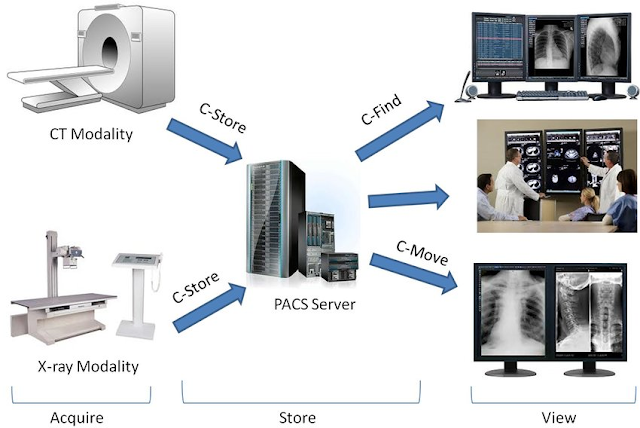Access Medical Images Instantly Without Desktop Downloads
Medical imaging has changed dramatically. You don't need clunky desktop software anymore to view CT scans, MRIs, or X-rays.
Today's online DICOM
reader
tools let healthcare professionals access medical images from any browser,
anywhere in the world.
This
shift transforms how doctors collaborate and makes patient care more efficient.
What Makes Remote Medical Imaging Possible
Medical
images are stored in a specific format called DICOM (Digital Imaging and
Communications in Medicine).
Think of
DICOM as the universal language for medical images. Every CT scan, MRI, and
X-ray uses this format, making it the standard across hospitals worldwide.
Web-based
DICOM viewers process these files locally on your device through the browser,
ensuring data security while eliminating the need for additional software.
This
means your patient data stays on your computer while you get full viewing
capabilities.
The
technology behind this relies on HTML5
and JavaScript. These web technologies can handle complex medical imaging
tasks that previously required expensive desktop programs. Your browser becomes
a powerful medical imaging workstation.
Key
Advantages of Browser-Based Medical Viewing
Instant Access Anywhere You can view medical images from your office,
home, or even while traveling. All you need is an internet connection and a web
browser. This flexibility proves invaluable during emergencies or when
consulting on cases remotely.
No Installation Headaches Traditional DICOM viewers require IT
departments to install, update, and maintain software across multiple
computers. Web-based solutions eliminate these steps entirely. You simply open
a website and start viewing images.
Cross-Platform Compatibility Whether you use Windows, Mac, or Linux,
browser-based viewers work the same way. Modern web-based solutions provide
consistent functionality across personal computers, tablets, and smartphones.
This consistency reduces training time and technical support issues.
Automatic Updates Desktop software requires manual updates that
often interrupt workflows. Web applications update automatically in the
background, ensuring you always have the latest features and security patches.
Security
Considerations That Matter
Patient
privacy remains the top concern when accessing medical images remotely.
Reputable web-based DICOM viewers implement several security layers:
Local Processing Your medical images never leave your
computer. The web application processes files locally, meaning sensitive
patient data doesn't travel to external servers during viewing.
Encrypted Connections All data transmission uses HTTPS encryption,
the same security standard used by banks. This protects information as it moves
between your computer and the web application.
HIPAA Compliance Professional-grade online viewers comply with
healthcare privacy regulations. They include audit trails, user authentication,
and data handling procedures that meet medical standards.
Popular
Web-Based DICOM Solutions
Several
platforms offer robust online medical image viewing:
|
Platform Type |
Key Features |
Best For |
|
Browser-based
viewers |
No
installation, instant access |
Quick
consultations, emergency viewing |
|
Cloud
PACS systems |
Full
workflow management |
Large
healthcare organizations |
Free Online Options Many websites offer basic DICOM viewing at no
cost. These work well for educational purposes or simple image review. However,
they may lack advanced measurement tools or specialized imaging features.
Enterprise Solutions Larger healthcare systems often choose
comprehensive platforms that integrate with existing hospital systems.
These
solutions enable seamless imaging access on any device while supporting
efficient telehealth services and teleradiology workflows.
Technical
Requirements You Need
Most
web-based DICOM viewers have minimal system requirements:
● Modern web browser (Chrome, Firefox, Safari, or Edge)
● Stable internet connection for initial loading
● 4GB RAM minimum for smooth performance with large image sets
● Graphics card recommended for 3D reconstructions
The
beauty of web-based solutions lies in their simplicity. If you can browse
websites and watch videos online, you can view medical images through these
platforms.
Real-World
Applications in Healthcare
Emergency Medicine Emergency departments use remote imaging
access to quickly consult with radiologists. This technology enables rapid
transmission and interpretation of X-rays, CT scans, and MRIs from one location
to another, reducing diagnosis time in critical situations.
Rural Healthcare Small hospitals in remote areas often lack
on-site radiologists. Web-based viewing allows these facilities to share images
with specialists in major medical centers, ensuring patients receive expert
interpretation regardless of location.
Medical Education Medical students and residents use these
platforms to study clinical images and develop diagnostic skills. Professors
can share interesting cases with students instantly, enhancing learning
opportunities.
Second Opinions Doctors seeking colleague input can quickly
share images without burning CDs or dealing with file transfer complexities.
This streamlined sharing improves patient care through collaborative diagnosis.
Making the Transition from Desktop Software
Moving from traditional desktop viewers to web-based solutions
requires some planning:
Start Small Begin with non-critical cases to familiarize
yourself with the new interface. Most healthcare professionals adapt quickly,
but allowing time for adjustment prevents workflow disruptions.
Train Your Team While web-based viewers are generally
intuitive, brief training sessions help staff understand new features and
keyboard shortcuts. Staff unfamiliarity with new software tools can initially
increase interpretation lag times, so proper training prevents these delays.
Test Integration Ensure your chosen web viewer works with
existing hospital systems. Some platforms offer direct integration with
electronic health records, while others require manual file uploads.
The future of medical imaging clearly points toward web-based
solutions. These platforms eliminate technical barriers while maintaining the
security and functionality healthcare professionals need.
Online DICOM reader technology continues advancing, making remote medical image access more powerful and user-friendly than ever before.





Comments
Post a Comment